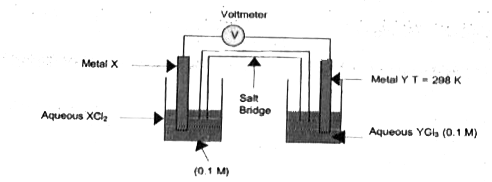E∘cell and ΔG0 are related as:
ΔG0=nFE∘cell
ΔG0=−nFE∘cell
ΔG0=−nFE∘cell
ΔG0=mFE∘cell
The correct Answer is:D
To solve the question regarding the relationship between standard cell potential (E°cell) and standard Gibbs free energy change (ΔG°), we can follow these steps:
1. Understand the Relationship: The relationship between standard Gibbs free energy change (ΔG°) and standard cell potential (E°cell) is given by the equation:
ΔG∘=−nFE∘cell
where:
- ΔG° = standard Gibbs free energy change
- n = number of moles of electrons transferred in the redox reaction
- F = Faraday's constant (approximately 96,485 C/mol)
- E°cell = standard cell potential (or standard electromotive force)
2. Identify the Variables: In the equation, identify the components:
- ΔG° is the energy available to do work at standard conditions.
- E°cell represents the potential difference that drives the electrochemical reaction.
3. Analyze the Options: The question provides multiple options regarding the relationship. We need to find the one that correctly represents the equation derived above.
4. Select the Correct Option: Based on our understanding of the relationship:
- The correct expression is:
ΔG∘=−nFE∘cell
- Therefore, if option 2 states this relationship, it is the correct choice.
Conclusion:
The correct answer is option 2, which states:
ΔG∘=−nFE∘cell
ΔG∘=−nFE∘cell
where:
- ΔG° = standard Gibbs free energy change
- n = number of moles of electrons transferred in the redox reaction
- F = Faraday's constant (approximately 96,485 C/mol)
- E°cell = standard cell potential (or standard electromotive force)
- ΔG° is the energy available to do work at standard conditions.
- E°cell represents the potential difference that drives the electrochemical reaction.
- The correct expression is:
ΔG∘=−nFE∘cell
- Therefore, if option 2 states this relationship, it is the correct choice.
The correct answer is option 2, which states:
ΔG∘=−nFE∘cell
Topper's Solved these Questions
Similar Questions
(a) What type of a battery is the lead storage battery ? Write the anode and the cathode reactions and the overall occuring in a lead storage battery when current is drawn from it.
(b) In the buttom cell, widely used in watches the following reaction take place
Zn(s)+Ag2O(l)→Zn2+(aq)+2Ag(s)+2OH−(aq).
Determine E∘ and ΔG∘ for the reaction.
(given : E∘Ag+/Ag=+0.80V,E∘Zn2+/Zn=−0.76V)
View SolutionIf the E∘cell for a given reaction has a negative value, then which of the following gives the correct relationships for the values of ΔG0 and Keq-
View SolutionThe following diagram shown as electrochemical cell in which the respective half-cells contains aqueous 1.0M solutions of the salts XCl2andYCl3. Given that
3X(s)+2Y3+(aq)→3X2+(aq)+2Y(s)εcell>0

E∘X/X2+=0.20v,E∘Y/Y3+=0.40V the E∘cell of the above designed cell is
View SolutionIf the E∘cell for a given reaction has a positive value, then
which of the following gives the correct relationship for the values
of ΔG∘ and Keq :-
View SolutionCalculate the cell e.m.f. and ΔG for the cell reaction at 298K for the cell.
Zn(s)∣∣Zn2+(0.0004M)∣∣∣∣Cd2+(0.2M)∣∣Cd(s)
Given, E∘Zn2+/Zn=−0.763V,E∘Cd+2/Cd=−0.403V at 298K.
F=96500Cmol−1.
View SolutionConsider the following reaction,
Zn(s)+Cu2+(0.1M)→Zn2+(1M)+Cu(s) above reaction, taking place in a cell, E∘cell is 1.10V.Ecell for the cell will be (2.303RTF=0.0591)
View SolutionStatement : If two half reaction with electrode potential E∘1 and E∘2 gives a third reaction then,
ΔG∘3=ΔG∘1+ΔG∘2
Explanation : E∘3=E∘1+E∘2
View SolutionIf Eɵcell for a given reaction is negative, which gives the correct relationships for the values of ΔGɵ and Keq?
View SolutionStatement-1: For the reaction:
Ni2++2e−→Ni and Fe2++2e−→Fe
⇒E∘Fe2+∣Fe<E∘Ni2+∣Ni and E∘Red>0
⇒ So Fe electrode is cathode and Ni electrode is anode.
Statement-2: If ΔG∘<0 and E∘Cell<0, then , cell is feasible.
View SolutionCalculate standard potential of cell E0cell by using E0_(Al3+∣Al) and E0Cu2+∣Cu as –1.66V and + 0.34V respectively
View Solution
